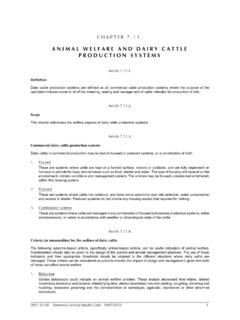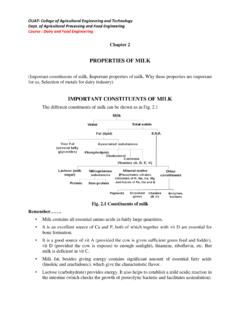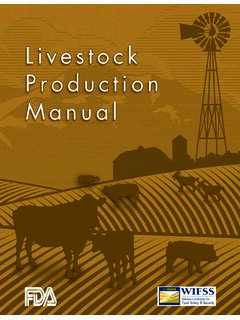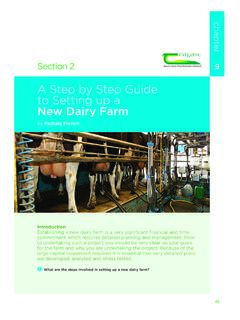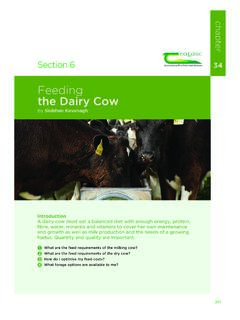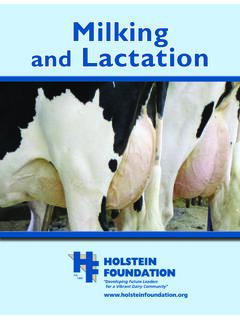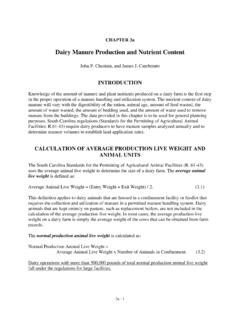Transcription of Cattle Types and Breeds Characteristics and Uses
1 The subject of Breeds intrigues most Cattle for beef Cattle production, Breeds are only part of agenetic strategy that should include:nMatching applicable performance or functional lev-els to environmental, management, and marketingconditions;nChoosing a breeding system, either continuous (inwhich replacement females are produced within theherd) or terminal (in which replacements are intro-duced externally); andnSelecting genetic Types , Breeds and individuals with-in the Breeds that are compatible with the perfor-mance level needed and breeding system chosen. Genetic classifications and breedsCattle can be divided into two basic classifications, Bostaurusand Bos indicus. Bos taurus, or non-humped, cattlein the United States originated in the British Isles and west-ern continental Europe. Bos indicus(also called Zebu), orhumped, Cattle arose in south central Asia.
2 There aresome intermediates containing both Bos taurusand Bosindicus. Some intermediates created in the United States,particularly in Texas, are commonly referred to asAmerican it has no strict definition, a breed can bedescribed as animals of common origin with certain distin-guishing Characteristics passed uniformly from parent tooffspring. Breed Characteristics result from both naturalselection and from that imposed by people. In this publi-cation, specific Characteristics or functional levels arebased on estimates of breed averages. Individuals varyconsiderably within Breeds . Some Breeds were created by combining establishedbreeds. A composite breed is formed from two or morebreeds, usually in exact percentages that vary dependingon the goals of the breed. Specific provisions are imple-mented over generations to retain the most hybrid term synthetic often is used interchangeably with composite.
3 But here it applies to Breeds formed frompools of two or more Breeds without regard to parentalbreed percentages or heterosis retention. Many new composites and synthetics are being creat-ed. Their Characteristics are those of the Breeds have registry associations that recordancestry, define and document Characteristics , and pro-mote the breed. Currently, more than 75 Breeds can beregistered in the United States. Functional traits or characteristicsThe major functional traits important in beef productioninclude body size, milking potential, age at puberty, hotclimate adaptability, fleshing ability, muscle expression,cutability, and sizeis best evaluated as weight at a stated levelof condition or body fatness. Weights at all ages tend tobe positively related: That is, Cattle heavier at birth tend tobe heavier throughout life, though there are larger animals usually gain weight faster, andweight and nutritional requirements for body maintenanceare closely related.
4 Size is discussed in the Extension publi-cation L-5192, Body Size and milking Level for BeefProduction. Frame score, an objective measure of skeletaldimension used to estimate current and future body size,is discussed in the Extension publication L-5176, FrameScore and Weight of Cattle . An important irregularity in Bos indicusoccurs in bodysize relationships. Calves from damscontaining Bos indi-cusinheritance are relatively small at birth, usually causingfew difficulties in calving. However, calves by Bos indicussiresout of Bos taurusdams often are relatively large, socalving may be more difficult. milking potentialis the genetic capability to producemilk. This is not actual volume of milk produced, whichalso is influenced by the cow s nutrition and the calf sgrowth potential and nursing pressure. To characterizemilking potential accurately, evaluate it relative to bodysize.
5 Higher- milking females need more nutrients for bodymaintenance and require higher-quality diets, even whennot lactating. Again, consult L-5192, Body Size andMilking Level for Beef Production. Age at pubertyrelates to body size, milking potential,and genetic classification. Smaller individuals and higher- milking Types usually mature earlier, whereas Bos indicusmature relatively late. Higher- milking females, even largeones, often reach puberty and conceive when relativelyyoung. But because they may become thin after beginninglactation, subsequent fertility can suffer. Although Bos indi-custypes reach puberty relatively late, their productive lifeusually is Types and BreedsCharacteristics and UsesStephen P. Hammack**Professor and Extension Beef Cattle Specialist; The Texas A&MUniversity climate adaptabilityis highest in Cattle with Bosindicusinheritance, but some Bos taurusare reasonablyheat tolerant or tropically adapted.
6 Animals with lighter-colored, short hair coats and dark skin are most humidity intensifies effects of heat, especially sincehot, humid climates often add the stresses of parasites andlow-quality forage. Heat with humidity stresses Cattle thatfail to shed long, thick hair coats, particularly dark-coloredones. As might be expected, animals tolerant to hot cli-mates are less adapted to cold. Fleshing abilityis the body s capacity to fatten andretain fat. Fleshing ability tends to drop with increases ingenetic body size, maintenance requirements relative tosize, milking level, and inherent muscularity. Animals poor-ly adapted to their environment generally are low in flesh-ing ability. Bos indicusoften flesh easier than other typeson low-quality forage and roughage. Easy-fleshing cattletolerate periods of nutritional energy deficiency more easi-ly and therefore may reproduce more consistently, butthey also over fatten more readily in the feedyard unlessproperly expressionis inherent muscularity, independentof other body tissues.
7 Muscling is the second most impor-tant factor in cutability. Heavy-muscled Types often arelow in fleshing ability, so reproductive efficiency may , or percentage of lean, is usually evaluated inslaughter Cattle as USDA Yield Grade. Cutability dependson relative amounts of fat (which varies greatly), muscle,and bone (which varies least). When genetic Types orbreeds are compared for differences in cutability, it isassumed that the Breeds have similar nutrition levels. Butproducers can readily alter inherent cutability differencesby varying nutrition to achieve similar degrees of fatness. Marbling, or intramuscular fat, is the primary factordetermining USDA Quality Grade, an indicator of thepalatability factors of tenderness, juiciness, and increases with age up to physiological maturityand generally is higher in earlier-maturing and higher-milk-ing Types .
8 Bos indicusand most heavy-muscled, low-milk-ing Types have relatively low marbling. Because marblingrelates somewhat to body fatness, especially in comparingbreeds or Types , there is usually a trade-off between yieldgrade and quality grade. As one increases, the otherdeclines. Breeds and functional typesTable 1 lists Characteristics of the major Breeds of cattlein Texas those most numerous or most familiar in thestate by estimates of purebred breed-wide A lists other Breeds with registry genetic classification and levels of functional traits, Breeds can be grouped into these functional Types : British Beef:British-originated Breeds and combinationsused for beef production Beef:Continental European Breeds andderivatives developed exclusively for beef are part of what are sometimes called exotics. Dual Purpose: Breeds selected for both beef and dairyproduction in their native areas, mostly continentalEurope, and combinations of beef and dairy Breeds .
9 DualPurpose Breeds are used only for beef in the UnitedStates. They are the other part of exotics. Dairy:originating in western Europe and selected inthe United States for dairy purposes only, with beef pro-duction as a Indicus:of pure or very high-percentage Bos indi-cusbackground and used only for beef :includes beef Breeds created in the UnitedStates from combinations of about one-fourth to one-halftropically adapted inheritance, typically the Bos indicus-derived Brahman, along with British Beef, ContinentalBeef, or Dual :includes Breeds that cannot be placed logi-cally in any of these groups, often characterized by partic-ular emphasis on certain functional levelsto production criteriaClimate and nutrition are key variables affecting wherediffering Types and Breeds can be produced. When cattleare not adapted to climatic conditions, production hot, humid climates, Cattle benefit from some Bos indi-cusor other tropically adapted genetics.
10 Table 2 shows the effects of nutrition on optimum lev-els of three primary production functions in cow herds. Ingeneral, as nutrition declines, the smaller, lower- milking ,easier-fleshing Types are better adapted and more effi-cient. This is discussed in detail in L-5192, Body Size andMilking Level in Beef Cattle . Appropriate functional levels can differ, depending onthe breeding system implemented. Cattle for general-pur-pose, continuous systems must contain a blend of impor-tant production traits in both sires and , specialized sire and dam Types are useful interminal systems. To reduce cowherd nutritional needs,terminal dams can be relatively small, complemented byhigh-growth sires. Maternal ability is unimportant in termi-nal sires because their heifers are not kept for replace-ments. For more discussion on breeding systems, seeExtension publication L-5207, Breeding Systems for BeefProduction.
